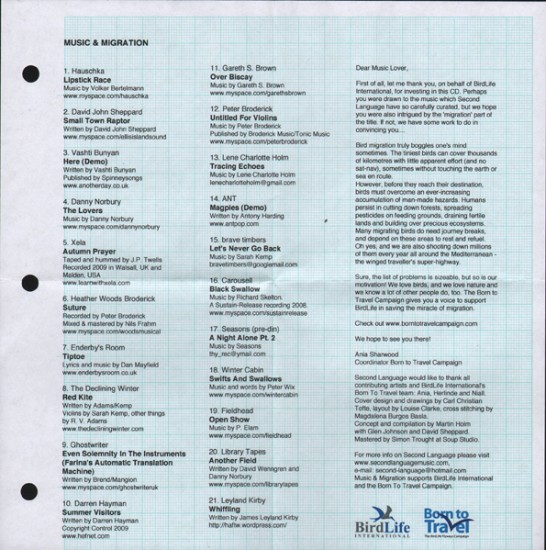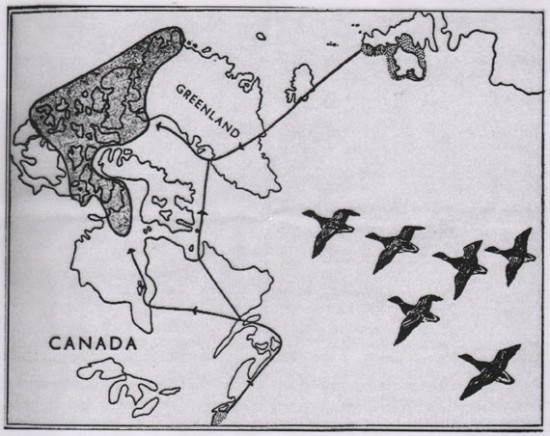First mentioned on CBTR by Ceri Levy in his Bird Effect Diary of August 2009, the Music & Migration compilation is now a beautiful reality.
David Sheppard tells us all about it;
Perhaps it’s an innate empathy with birdsong, or the fact that autostrada perambulating troubadours enjoy kinship with anything which regularly ‘migrates’ along familiar pathways in order to keep itself alive (while, ahem, mating, with preternatural regularity), but whatever the reason, musicians have long exhibited a very particular affinity with our feathered friends – as The Byrds, Doves, Guillemots, Pigeon Detectives, Eagles, Black Crowes, etc, would surely attest. That was certainly the opinion of Copenhagen’s Martin Holm: experimental musician, incorrigible record collector and indefatigable campaigner for global conservation alliance, BirdLife International. When the latter organisation wanted to increase awareness of the burgeoning threat to the habitats and ‘flyways’ of migratory birds it seemed perfectly logical, to Martin anyway, to ask musicians to be the mediators of the message.
Having launched a MySpace page with the self-explanatory title Music & Migration, detailing the encroaching threat to itinerant birdlife, Martin set about finding sympathetic musicians, hoping he might secure a smattering of tracks which would, in turn, attract traffic to the site. To do this, he simply looked along his record shelves and selected his favourite artists from the world of post-classical composition, contemporary folk song and ambient soundscaping – musicians whose work, to varying degrees, enjoys an implicit relationship with landscape and the natural world. The artists he chose to approach included American wunderkind composer Peter Broderick, German prepared piano maestro Volker Bertelmann – aka Hauschka, British cellist Danny Norbury, Type Records head honcho and electronic artist John Twells – aka Xela, former Hefner frontman Darren Hayman and celebrated UK soundscapers Richard Skelton and Leyland Kirby – all substantial ‘names’ in their fields. With them on board, he reasoned, Music & Migration could start fulfilling its titular brief.
So beguiled by Martin’s ingenuous spirit (not to mention the worthiness of the cause) were those he petitioned for an exclusive piece of music – their ‘mystique’ and cult status notwithstanding – that each responded with an unambiguous yes. Such was the positive reaction that in no time Martin had accrued a cornucopia of tracks – so many, in fact, that he couldn’t fit them all on his MySpace player and had to initiate a rotation system. This unexpected embarrassment of riches was not only one of quantity: the music was universally gorgeous – the majority of the pieces especially composed and recorded for the project. As disarming as the musicians’ largesse was, it would prove to be but the first of many curiously spontaneous, cockle-warming incidences that would see Music & Migration burgeon from a disarming nature conservation initiative into a lovely, much-coveted compilation album, and much more besides.
What motivated all this inspiring musicianly benevolence? Chastening facts like these. The habitats that migratory birds rely on to sustain their journeys throughout Europe, the Middle East and Africa, are being inexorably encroached upon and developed. Man-made obstacles such as wind farms and power lines placed in unsuitable locations, coupled with indiscriminate hunting, kill millions of migratory birds as they make their journeys each year. As a result, a huge variety of itinerant species are facing alarming decline. Many birds that are considered ‘common’ have, in fact, been decreasing drastically in number for decades, for example the Cuckoo, the Turtle Dove and the Barn Swallow. Almost half of all long-distance migrant bird species (those that voyage between continents) have declined over the last 30 years and more than half of the migratory raptors of the African-Eurasian region are showing a consistent plunge in population numbers. Moreover, ten per cent of all migratory species are now moving toward extinction.
Enter Birdlife International, a charitable body devoted, among other laudable conservation aims, to countering this apparently inexorable decline. Their brief involves preserving a network of important avian landscapes, especially wetlands, to ensure better protection for migratory birds along the African-Eurasian flyway, as well as campaigning to have large structures (the aforementioned wind farms, power lines etc) placed away from vital migratory routes. Other measures such as regulating the use of pesticides which poison birds, and outlawing spring hunting, are also designed to restore dwindling winged populations.
So, there was no questioning the worthiness of the cause. Among the legion musicians with whom it chimed were two of Martin’s London-based friends – Glen Johnson (of the band Piano Magic) and, well, me. Little persuasion was needed to have us donating music to the Music & Migration site – indeed we were completely enamoured of the whole project. As we listened to the accumulation of tracks, it quickly dawned on us how great this music would be sequenced into a ‘proper’ compilation record. Martin, Glen and I were so excited by this prospect that we began hatching plans for a bespoke record label to release the compilation. We also thought we could find one or two additional musicians for the project. Glen contacted Vashti Bunyan (with whom he has recorded in the past) and, true to form, even the famously reticent Vashti consented and recorded a lovely new track especially for Music & Migration. It was getting exciting now.
Starting a micro label was something that had been in the air for while, in fact. Glen had, de facto, already begun one, with a super-limited, ‘homemade’ release by his Textile Ranch side project. We decided to build on that, plumping, after some debate, on the name Second Language for our new venture – a designation hinting, we hoped, at the ‘alternative’ nature of the label as well as its lingua franca universality. Second Language would be a boutique imprint; the idea being to issue the Music & Migration album in a short run, limited edition, sheathed in lovingly hand-tooled, recycled packaging – an ethos that would sit as well with BirdLife International as it would with aesthete music punters.
As useful as MySpace had been to Martin’s initial concept, the three of us were equally fatigued by music’s modern digital ubiquity and were eager to reinstate the idea of records as cherishable, audio-visual artefacts – holistic, archivable objects. We envisaged a label that could release all kinds of unusual music and that was as open to highlighting charitable (or other) causes as it was the kind of innovative creativity that might otherwise get lost, crashing into the ‘man-made structures’ of orthodox music dissemination, if you will. We wanted labour intensive, hand-assembled sleeves, lots of insert ‘extras’ and a blanket rejection of dismal MP3 downloads. Where possible, we would insist, as Martin had from the start, on artists delivering us exclusive material, available for the mayfly lifespan of the release, then gone forever. From there, we developed the idea of basing the label’s ‘economics’ on subscriptions, with punters encouraged to take a chance on our curatorial abilities with regard to upcoming releases. The proceeds from this would be channelled into the funding of exciting future releases, with increasingly desirable packaging concepts. The ‘business model’ for Second Language is simply to make it as little like ‘business’ as possible.
To cut short a rather intense story of mastering, sequencing, screen-printing, paper-folding, rubber stamping, needlepoint sewing and more, by early January we had assembled a couple of hundred lavishly packaged Music & Migration albums, launched a Second Language website and even started signing up label subscribers. Word about the album and the label ‘migrated’ quickly. Influential record outlets like Normans and Rough Trade asked if they could stock Music & Migration (Norman made it ‘album of the week’ in late January, and promptly sold out of their copies in a matter of hours!). Subscribers started signing up from as far away as Japan, Peru and New Zealand; an Australian radio station started rotating our tracks; music websites and magazines like Mojo wanted a copy of the compilation to review (we honestly hadn’t even thought of approaching the press…) and so on.
As I write, we’re currently printing up a couple of hundred more sleeves for Music & Migration, but the demand continues to outstrip our ability to hand-make the things. Indeed, we’re sticking with our original ‘cherishable limited edition’ ethos and, after this repress we’ll not be manufacturing any more copies. Instead we’ll be moving on to our next release, an album by London artist Dollboy called Ghost Stations – a wonderful collection of psycho-geographic ‘interpretations’ of lost underground stations in London and Berlin (housed in a lavish, hand-printed sleeve, with all kinds of inserts, naturlich).
If that sounds like we’ve suddenly turned into record moguls, then let me disabuse of that notion. Ours is still a not-for-profit world of ink, cardboard, paper guillotines, roped-in girlfriends and tiny city flats sporadically transformed into chaotic craft factories. Nor have we forgotten the benevolent nature of Martin’s initial campaigning ideal; indeed, plans are already afoot for further ‘awareness-raising’ albums as well as Second Language concerts tied in with ornithological events. Moreover, the Music & Migration compilation seems to have pervaded the bird-watching and conservation fraternities where it’s been greeted with a universal glow of approval – for its aesthetic qualities as much as for it’s honourable intent – even by those who, chances are, had no previous knowledge of Vashti Bunyan, The Declining Winter, Heather Woods Broderick, Library Tapes, Leyland Kirby, Enderby’s Room et al.
We’re now in the early stages of formulating a follow-up compilation, possibly to be called Return Migration. If the birds can make their annual, against-all-odds re-appearance why shouldn’t we?
We have a limited number of copies of the ‘Music & Migration’ CDs for sale in the CBTR shop.

